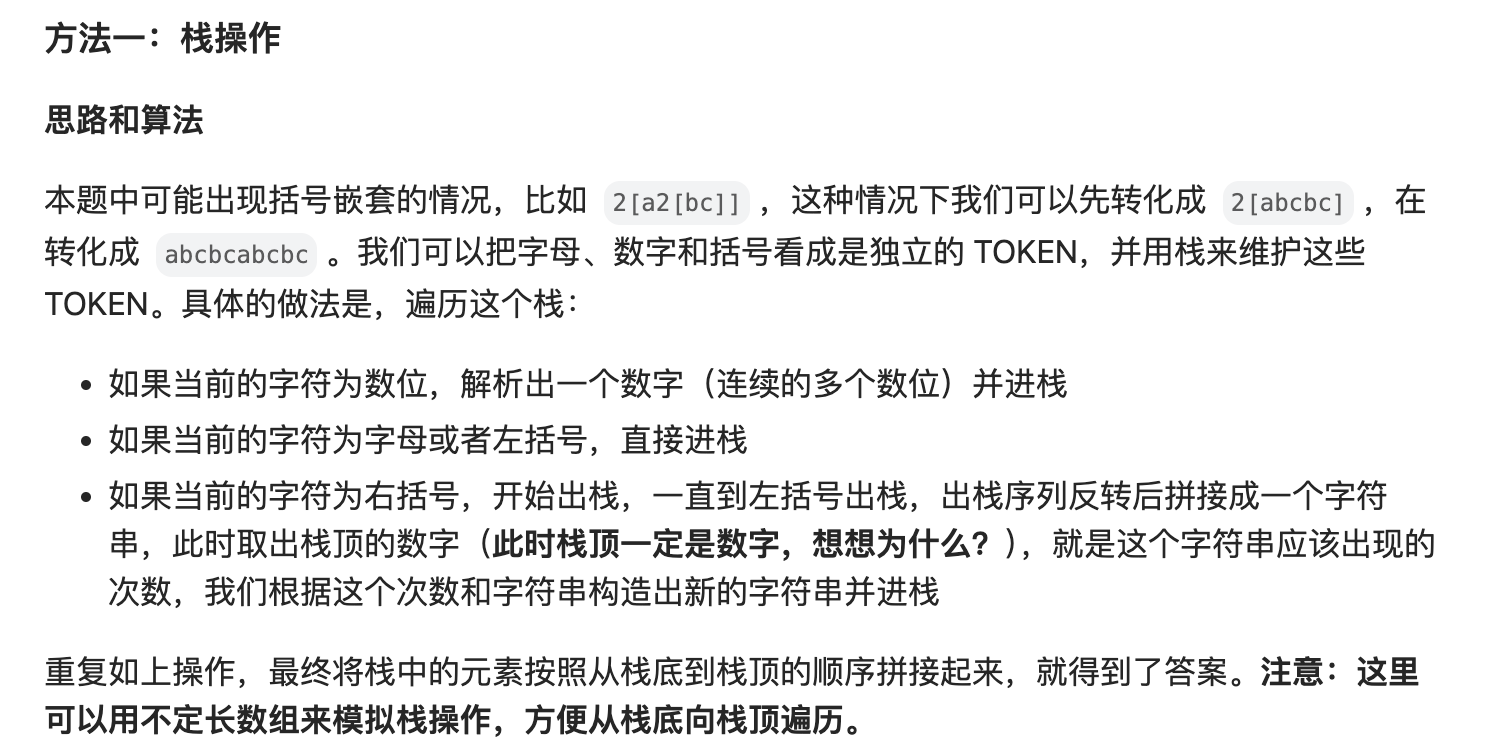
题目描述
394. 字符串解码
给定一个经过编码的字符串,返回它解码后的字符串。
编码规则为: k[encoded_string],表示其中方括号内部的 encoded_string 正好重复 k 次。注意 k 保证为正整数。
你可以认为输入字符串总是有效的;输入字符串中没有额外的空格,且输入的方括号总是符合格式要求的。
此外,你可以认为原始数据不包含数字,所有的数字只表示重复的次数 k ,例如不会出现像 3a 或 2[4] 的输入。
示例 1:
1
2
| 输入:s = "3[a]2[bc]"
输出:"aaabcbc"
|
示例 2:
1
2
| 输入:s = "3[a2[c]]"
输出:"accaccacc"
|
示例 3:
1
2
| 输入:s = "2[abc]3[cd]ef"
输出:"abcabccdcdcdef"
|
示例 4:
1
2
| 输入:s = "abc3[cd]xyz"
输出:"abccdcdcdxyz"
|
提示:
1 <= s.length <= 30s 由小写英文字母、数字和方括号 '[]' 组成s 保证是一个 有效 的输入。s 中所有整数的取值范围为 [1, 300]
解题思路

代码实现
1
2
3
4
5
6
7
8
9
10
11
12
13
14
15
16
17
18
19
20
21
22
23
24
25
26
27
28
29
30
31
32
33
34
35
36
37
38
39
40
41
42
43
44
45
46
47
48
49
50
51
52
53
54
55
56
57
58
59
60
61
62
63
| public class Solution394Case1 {
static int ptr;
public static String decodeString(String s) {
LinkedList<String> stk = new LinkedList<>();
ptr = 0;
while (ptr < s.length()) {
char cur = s.charAt(ptr);
if (Character.isDigit(cur)) {
String digits = getDigits(s);
stk.addLast(digits);
} else if (Character.isLetter(cur) || cur == '[') {
stk.addLast(String.valueOf(s.charAt(ptr++)));
} else {
++ptr;
LinkedList<String> sub = new LinkedList<>();
while (!"[".equals(stk.peekLast())) {
sub.addLast(stk.removeLast());
}
Collections.reverse(sub);
stk.removeLast();
int repTime = Integer.parseInt(stk.removeLast());
StringBuffer t = new StringBuffer();
String o = getString(sub);
while (repTime-- > 0) {
t.append(o);
}
stk.addLast(t.toString());
}
}
return getString(stk);
}
public static String getDigits(String s) {
StringBuffer ret = new StringBuffer();
while (Character.isDigit(s.charAt(ptr))) {
ret.append(s.charAt(ptr++));
}
return ret.toString();
}
public static String getString(LinkedList<String> v) {
StringBuffer ret = new StringBuffer();
for (String s : v) {
ret.append(s);
}
return ret.toString();
}
public static void main(String[] args) {
String s = "2[a2[bc]]";
System.err.println(decodeString(s));
}
}
|

